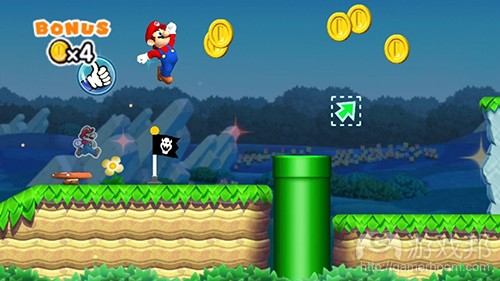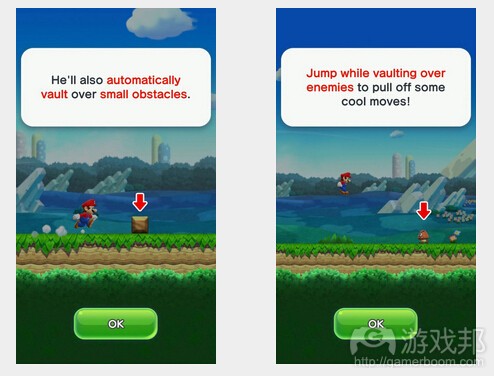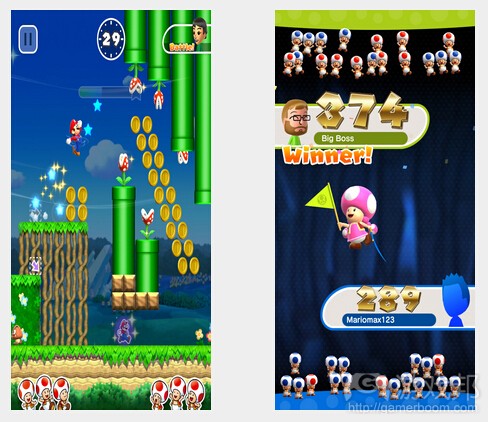解析《超级马里奥跑酷》的闪光点
作者:Dan Felder
在我写下本文的3天前,也就是12月15日的时候,《超级马里奥跑酷》问世了。虽然就像我们所预计的那样,游戏的销量迅速飙升,但同时这款游戏却只获得2.5颗星的评级。不过如此低的评级底下其实是一款真正出色的游戏。即尽管玩家抱怨着游戏的盈利结构,始终在线的要求以及其它种种问题,但是当你真正投入去玩这款游戏时便能够感受到它的魅力。
将《超级马里奥跑酷》称为跑酷类游戏的后进者其实是错误的。这款游戏的设计其实是关于优雅与基于技能的适应性的研究。《超级马里奥跑酷》并不像一款以马里奥为主题的手机游戏。它更像是带有一个按键的经典的马里奥平台游戏。
让我们着眼于一些经典的马里奥游戏玩法。
这是一个竞速破关世界,所以在最初的《马里奥兄弟》中你会觉得这不像是自己的游戏一样。但是这也是游戏的核心。即当你移向屏幕左边时你便能够跳跃。如果你能够适时跳跃,你便能够有效地玩游戏。否则你将在此受挫。所以这款游戏的核心便是关于适时跳跃。
让我们着眼于《超级马里奥跑酷》。
《超级马里奥跑酷》的游戏玩法与《超级马里兄弟》的竞速破关非常相似。尽管前者只拥有一个按键,但是这款游戏非常注重核心玩家输入,即适时跳跃。游戏强调了能让马里奥运行的元素并删除了其它所有内容。
但是一个出色的马里奥关卡并不只是按压适当的按键。关于那些你需要暂时停下来的时刻呢?就像当你需要小心跳到一个移动平台的时候。
那些带有暂停标志的红色砖块便是答案。当马里奥在这些砖块上奔跑时他们便会停止移动直至你在此轻敲屏幕。同样地,当马里奥降落在一个移动平台时,他便会自动跑到平台中心并开始等待,就好像那里有一个暂停砖块一样。这意味着玩家始终都能够完美地设置自己的下一次跳跃时间。
货币的布局也是围绕着游戏的需求。即比起分散在一些你能够随机选择进入的迷你平台挑战中,游戏中的货币在不同关卡中形成了一些定向路径。一个最典型的例子便是箭头。
看到图上的绿色箭头了吗?只要轻触它便能够创造一条从这里开始的货币路径(游戏邦注:这是其它方法所做不到的)。尽管玩家可能会从原本存在的货币路径中掉下,但是这一箭头能够有效吸引玩家的视线让其朝着适当的方向前进。这同时也能帮助玩家在心中分析自己需要前进的路线并且不会让画面错乱分布着金币。这种小小的决定便是这款游戏的突出之处。
为了能够在关卡设计中添加一些灵活性,设计师同样也需要使用不同类型的箭头。
看到地上的那些指向屏幕左边的蓝色箭头了吗?如果你在这些箭头上方跳跃,你便会向后跳跃。这种货币模式将设置一个特殊循环,即你能在向后跳跃的同时拾起货币,然后你将向后翻转获取粉色货币并朝着另一端向下跳跃。这些箭头的使用以及沿着墙壁的跳跃也能让玩家实现向后跳跃,如此便能让设计师呈现更多灵活性。
虽然不考虑货币去完成一个关卡非常简单,但是跟随着货币能够为玩家创造额外的动机,这是比花朵系统更有吸引力的。毕竟你需要真正触发一个区域中的所有花朵去完成该部分的挑战。而在《超级马里奥跑酷》中,货币虽然是人们想要的东西,但对于一些主要关卡来说它们只是可选择的对象。玩家可以根据自己的想法获得自己想要的货币。
这是关于关卡设计师用于创造基于一个按键系统的马里奥关卡的灵活挑战的一些工具。那敌人呢?如果玩家始终全速前进,他们将直接冲向goombas。
反复猛烈撞击敌人将会破坏游戏流。所以《超级马里奥跑酷》采取了与设置货币同样的方法去设置敌人。在地上直接冲向敌人并不会杀死玩家。因为马里奥会优雅地跃过敌人。但如果你是在马里奥跳起来时按压跳跃,你便能够基于自己所处模式获得奖励。这也将确保玩家始终身处关卡流中。
游戏还通过在关卡中分配不同奖励货币模式而区分了每一个关卡。第一种模式是在关卡中玩家能够轻松到达的位置上放置5个粉色货币。如果玩家能在拾起这5个货币的同时完成关卡便能够获得奖励并打开紫色货币。在游戏中紫色货币是较难找到的并且往往需要玩家收集到更复杂的技能。而完成这样的挑战将带给玩家黑色货币,通常玩家需要多次尝试才能获得所需技能去拾起黑色货币。因为《超级马里奥跑酷》并不会轻易让玩家往回走,比起其它马里奥游戏,在这里一次收集齐所有5个货币虽然更浪费时间但也更让人满足。
玩家在游戏中能够往后走的能力非常有限。不管何时当马里奥死去时,他便会在气泡中往后走。玩家可以轻敲屏幕让他在自己想要的地方再生。玩家并不能在每个关卡中一直重复这么做,但是如果玩家想要重新完成一次跳跃去获取特殊货币的话便可以在马里奥死亡前使用自己的一个气泡。
这款游戏的关卡是拥有时限的。因为如果不这样做玩家可能会在一个特定区域不断地跳跃。而时限让玩家只能适时在特定区域折腾自己,并不得不最终放弃而向后移动。虽然这种设置有时候会让我很无奈,但这却能够帮助我去获取完整的游戏体验。
结束前我们需要说说Toad Rally模式。
这是游戏中最有趣的模式。在Toad Rally中玩家可以基于不同顺序与其他玩家进行异步竞争。游戏会声称你正在与其他玩家的游戏风格进行对抗。虽然我不清楚这是如何决定的,但是我们会觉得这样的竞争非常激烈。玩家将快速通过一个充满货币的关卡,通过竞争去获取比对手更多的货币并创造更快速的移动。在上图的左边屏幕上,玩家是基于全3D马里奥模式在铺满货币的路径上跳跃着。而玩家的对手则是基于2D马里奥模式沿着屏幕下方路径前行。
任何简单的设计问题都可能导致玩家否认对方的货币。这将把整个模式变成始终赢钱的竞赛,即玩家可能将所有货币尽收囊中,或者游戏关卡将被分成两条路径。为了避免这一问题设计师可以让玩家进入同一过程的镜像中。即玩家将能看到对手在做什么,身处关卡中的哪个部分,并且玩家也可以同时拾起同样的货币。这款游戏的设计师留下了经典竞赛中的一个元素并在关卡中设置了旗帜。第一个碰到旗帜的玩家便能声称获得旗帜且得到大量货币。这也是玩家进一步向前的动力。
Toad Rally同时也掺杂了博彩心理,即在玩家奔跑的时候提供给他们多个“累积奖励”。Coin Rush能为玩家创造更多货币,也能够暂时为你创造一个黄色星星货币吸尘器。如果能够同时拥有这两个功能那就太棒了。
Toad Rally是以创造更多多样性与即时目标为动力。玩家总是希望马上能够打败对手而不只是朝着战胜另一个关卡不断前进。如果玩家遭遇失败,游戏便会提供给你在同一个地方再次面对同一个对手的机会。胜者便不会面对这样的选择。而因为玩家已经熟悉了这个关卡,所以将比第一次表现得更好。这也能够更加公正地取代负面体验。因为玩家将可能赢得再一次的对抗。
我敢保证我们将在之后几天或几周时间里看到更多有关《超级马里奥跑酷》的盈利策略的描述。所以我才不打算在此讨论这些内容。今天我的关注点主要是任天堂如何使用一个按键去创造这么一款马里奥游戏以及它是如何有效运行的。优雅是出色游戏设计最难得的特性,适应性则是最独特的挑战。
(本文为游戏邦/gamerboom.com编译,拒绝任何不保留版权的转发,如需转载请联系:游戏邦)
The Brilliance of Super Mario Run
by Dan Felder
Super Mario Run charged out on December 15th, three days ago as of this writing. While its sales have skyrocketed as we’d expect, the game is currently suffering a shocking 2.5 star rating. However, these low ratings mask a brilliant game. While players rightly complain about the monetization structure, always-online requirements, and other issues surrounding the experience Super Mario Run shines like an invincibility star when you’re actually playing the game.
Dismissing Super Mario Run as a late-comer to the runner genre is a mistake. The game’s design is a study in elegance and skillful adaptation. Super Mario Run doesn’t feel like a Mario-themed mobile game. It feels like you’re playing a classic Mario platformer with just one button.
Let’s take a look at some classic Mario gameplay.
This is a world record speedrun, so it might not look like your own experiences with the original Mario Bros. However, this is the core of the game. You move to the right of the screen and time your jumps. If you time your jump well, things work out for you. If you don’t, you hit a setback. At its core, Mario Bros. is all about timing your jumps.
Let’s take a look at Super Mario Run.
Super Mario Run’s gameplay ends up looking very similar to the Mario Bros. speedrun. Despite having only one button to work with, the game focuses in on the core player input: timing jumps. It automates the rest for you. They focused on the essence of what makes Mario work and stripped away everything else.
However, a good Mario level often isn’t played just holding down the right button. What about those times when you need to stop for a second? For example, what if you need to carefully time a jump onto a moving platform?
See that red brick with the pause sign? That’s their answer. The moment Mario runs on top of that brick he’ll stop moving until you tap the screen again. Likewise, when landing on a moving platform Mario will automatically run to the center of the platform and wait as though there was a pause brick there. This means you’re always perfectly set up for your next timed jump.
The layout of coins also works around the game’s needs. Instead of being scattered across the screen in half a dozen mini platforming challenges you can optionally engage in, the coins form directional paths through the levels. One of the best examples of this are the arrows.
See that green arrow? Touching it will create a path of coins extending from its tip that otherwise won’t appear. While a player might otherwise fall diagonally through a coin path that already exists, the arrow gives players a focused section of the screen to jump in and a direct payoff right after. It also helps players mentally parse their paths going forward without cluttering the screen with golden coins. It’s these kinds of small decisions that really make the game hum.
The designers also used a different kind of arrow in order to get some added flexibility in their level design.
See those blue arrows on the ground, pointing to the left side of the screen? If you jump while on those arrows, you’ll jump backwards. This coin pattern sets up a fancy loop, where you pick up the coins on the ground while running forward, then time your jump to flip backwards up the path to the pink coin and down the other side. The use of these arrows, along with wall jumps that provide a similar backwards leap, gives the designers a lot more flexibility.
Completing levels without caring about the coins is often easy, but following the coins creates an ‘extra credit’ motivation that’s even more accessible than Flower’s similar system. After all, you need to actually trigger all the flowers in an area to complete that section of Flower. In Super Mario Run, the coins are clearly desirable but they’re entirely optional for the main levels. You can get as many or as few of them as you wish, but dang does it feel good to get them.
Alright, that goes into some of the tools the level designers use to create the flexible challenges of a great Mario level with a simple one-button system. But what about the enemies? Most players are going to run straight into goombas if they’re always charging ahead full speed.
Repeatedly slamming into enemies would kill the flow. Instead Super Mario Run takes a similar philosophy to enemies as it does with the coins. Running straight into an enemy on the ground doesn’t kill you, Mario gracefully vaults over them. However, if you hit Jump while vaulting you get a bonus depending on the mode you’re in. This keeps you in the flow of the level.
The game also gets extra use out of each level by scattering different patterns of bonus coins throughout them. The first pattern places 5 pink coins throughout the level in easily reached locations. Completing it while picking up all 5 coins earns you a bonus and unlocks the purple coins. The purple coins are harder to find and require more impressive acrobatics to collect. Completing that challenge brings out the black coins, which demand acrobatics that will take some serious practice to pull off. Because Super Mario Run doesn’t easily allow you to go backwards, collecting all five coins in one run is a much more time-consuming and satisfying feat than in other Mario titles.
You do have a limited ability to go backwards though. Whenever Mario dies, he floats backwards through the level in a bubble. You can tap the screen to respawn him when he’s at the place you want. You can only do this a limited number of times each level, but you can also use one of your bubbles even before Mario’s death if you want to re-do a tricky jump to pick up a special coin.
Finally, levels have time limits attached. Otherwise the players might spend forever in certain wall-jumping sections trying to make a particular jump over and over again. The time limit allows you a reasonable amount of excess time to frustrate yourself in these sections, but ultimately demands you give up and move forward. This limitation might annoy me while I’m experiencing it, but it’s definitely helped my experience overall.
Before we wrap up though, we need to talk about Toad Rally.
This is the most fun mode of the game. In Toad Rally you compete asynchronously against other players in mashups of various courses. The game claims you’re playing against the other player’s ‘style’. I’m not sure how that’s determined, but the competition feels intense. You race through a coin-rich level, competing to pick up more coins than your opponent and pull off more fancy moves (such as jumping while vaulting over an enemy). In the above left screen, you’re the full 3D Mario at the top going for a jump to pick up that rich path of coins. Your opponent is the 2D Paper-Mario figure taking a path along the bottom of the screen.
The easy design mistake would be allowing players to deny each other coins. This would turn the entire mode into a race to always be ahead, as you’ll get the lion share of all the coins, or else necessitate continually breaking levels into two paths. Instead the designers simply let players engage in mirrors of the same course. You can see what your opponent is doing, and where they are in the level, and you can both pick up the same coins. The designers did maintain one aspect of a classic race, spawning flags throughout the level. The first player to touch a flag claims it and gets a burst of coins. This is your incentive to be further ahead.
Toad Rally also taps into gambling psychology, providing multiple ‘jackpots’ you can hit during your run. Coin Rushes spawn far more coins for you to pick up, while snagging a yellow star vacuums in coins around you for a short while. Having both at once is exponentially awesome.
Toad Rally works by creating increased variety and an immediate goal. You want to beat your opponent right now, not just eventually progress toward defeating yet another level. If you lose, the game provides you with an option to play the same opponent again on the same course. Winners don’t get this option. Because you’re now more familiar with the course you’re likely to do a lot better than you did the first time. This helps replace a negative experience with a sense of justice. You won the rematch.
I’m sure we’ll see many pieces in the upcoming days and weeks about Super Mario Run’s unusual monetization strategy. That’s not my focus here. My focus is on how Nintendo made a Mario game with just one button and why it works so well. Elegance is the most elusive quality of excellent design and adaptations are uniquely challenging.
Excellent job Nintendo. Now let’s talk about that always-online thing…(source:gamasutra)
下一篇:是设计游戏还是随便拼凑一个内容?












































 闽公网安备35020302001549号
闽公网安备35020302001549号